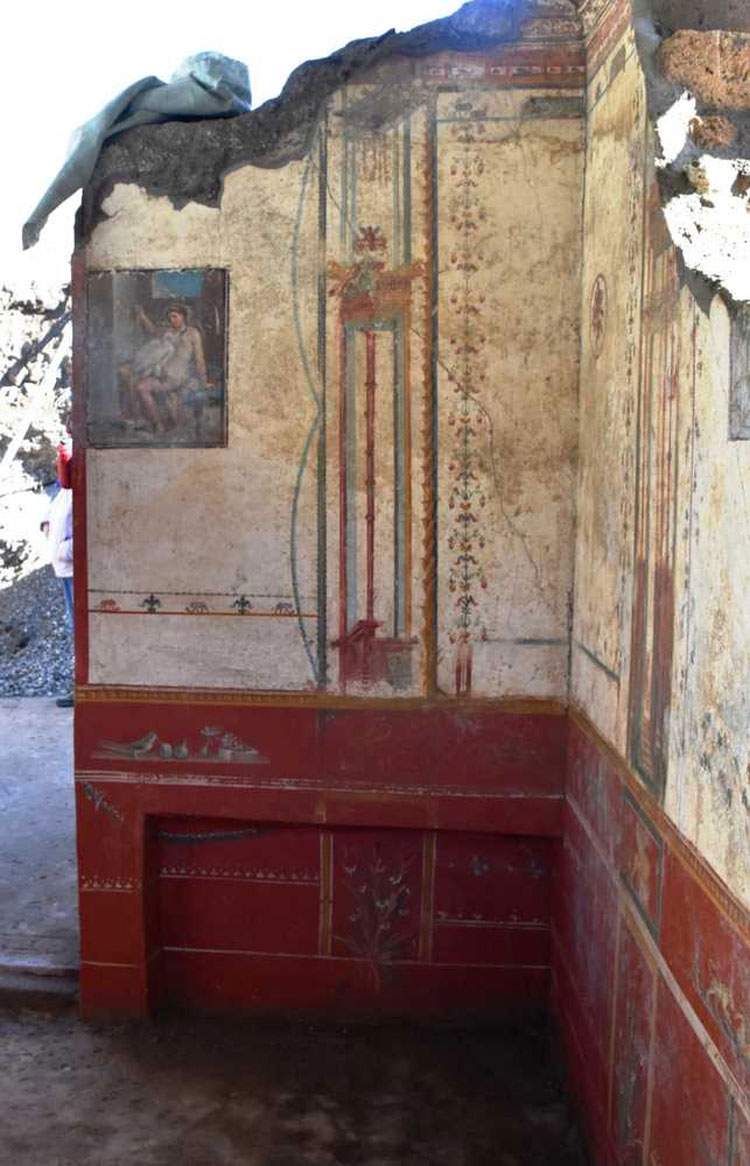Pompeii, refined frescoed alcove resurfaces in Regio V excavations
During excavations in Pompeii ’s Regio V, an alcove was unearthed, as could be guessed from the splendid episode of Leda and the Swan, which resurfaced months ago along Via Vesuvius. Behind the room, part of the dwelling’s atrium also comes back to light, with vividly colored walls and the fresco of Narcissus, in the center of one of them, which sees him reflected in the water enraptured by his image, according to classical iconography.
The entire room of Leda is characterized by refined decorations and delicate floral ornaments, interspersed with griffins with cornucopias, flying cupids, still lifes and scenes of animal fights; while on the ceiling, which collapsed under the weight of the lapilli, stretched the harmony of these fine designs, the fragments of which were recovered by restorers to reassemble the texture.
In the atrium of Narcissus, the trace of the stairs that led to the upper floor is still visible, as well as the space of the under-stairs, which was used as storage for a dozen glass containers, eight amphorae and a bronze funnel. A bronze situla (container for liquids), on the other hand, was found next to the impluvium.
“The beauty of these rooms, evident from the first discoveries, prompted us to modify the project and continue the excavation to bring to light the Leda room and the atrium behind it. This will enable us in the future to open at least part of this domus to public use. The excavation of it was made possible as part of the larger work of securing and reprofiling of the excavation fronts, envisaged by the Great Pompeii Project, which is affecting the more than 3km of perimeter bordering the unexcavated area of Pompeii. In reshaping the slope of the fronts that loomed ominously over the structures already in the light, these exceptional finds came to light. At this delicate stage, colleague Massimo Osanna is continuing the scientific direction of the excavation to provide his valuable and competent support and ensure a line of scientific continuity to the excavation activities,” said Alfonsina Russo.
“The extraordinary discoveries of this site continue. The scene of a myth, that of Narcissus, which is well known and repeated many times in Pompeii, is repeated in the atrium of the house. The whole ’environment is pervaded by the theme of joie de vivre, beauty and vanity, emphasized also by the figures of maenads and satyrs who, in a sort of Dionysian courtship, accompanied visitors inside the public part of the house. A deliberately luxurious decoration and probably pertaining to the last years of the colony, as evidenced by the extraordinary state of preservation of the colors,” added Massimo Osanna.
Image: Leda’s Room Ph. Credit MiBAC
 |
| Pompeii, refined frescoed alcove resurfaces in Regio V excavations |
Warning: the translation into English of the original Italian article was created using automatic tools. We undertake to review all articles, but we do not guarantee the total absence of inaccuracies in the translation due to the program. You can find the original by clicking on the ITA button. If you find any mistake,please contact us.





























